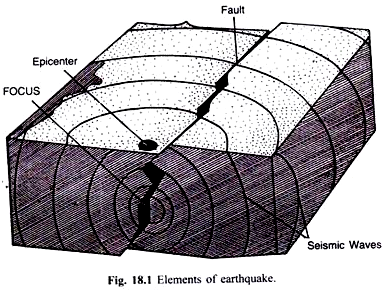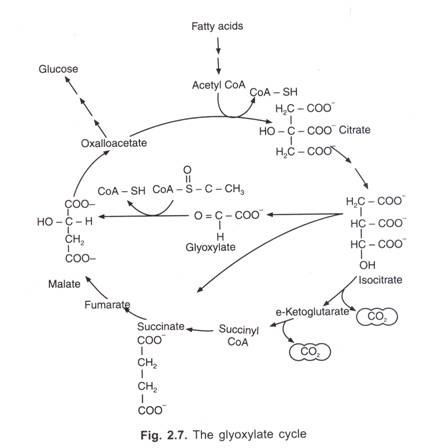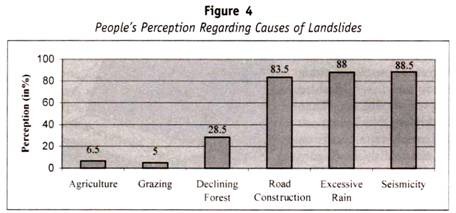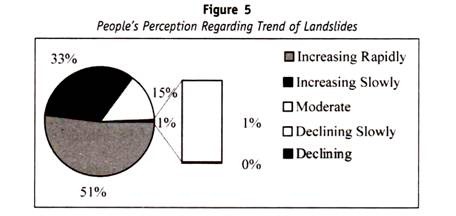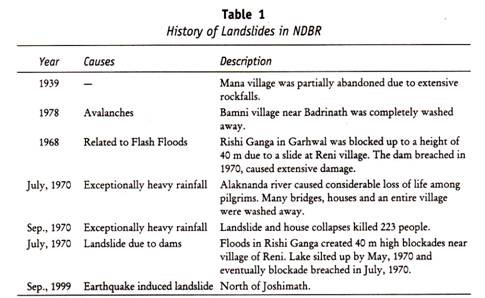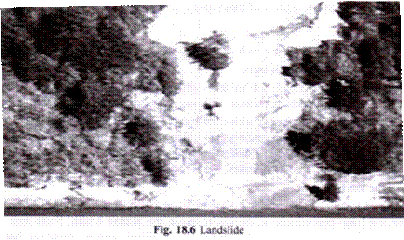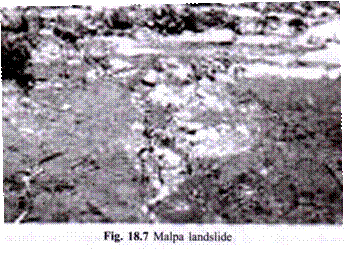Earthquakes, floods and landslides, etc. are natural environmental hazards of disastrous consequences.
In recent years these hazards took toll of thousands of lives and caused massive destruction of property.
These have adversely affected the vital sectors of our development as agriculture, communication, irrigation, power projects and rural and urban settlements.
The time and cost overrun in some cases have been enormous but their indirect impact on our economy has never been calculated. India is among the world’s most disaster prone areas and a large part of the country is exposed to natural hazards, which often turn into disasters causing loss of life and property. The unique geo-climatic conditions have exposed this country to natural catastrophes.
Disasters can be defined as a sudden, accidental event of great magnitude that causes considerable damage to life and property. They are sudden, drastic and normally occur without any alarm or warning. Some disasters may be short lived such as earthquakes and some other may be of long duration, such as floods.
However, irrespective of the duration of a disaster, the damage in the form of deaths, injuries and losses of property is immense. The magnitude of the disasters can be judged by the fact that only during the past two decades, occurrences of floods, earthquakes, landslides, cyclones, etc. have killed several million people.
Most of the disasters have a natural origin, however, some disasters are manmade as well. On this basis, disasters can be broadly classified into two groups:
Natural disasters:
When disasters occur due to natural forces they are called natural disasters, over which man has hardly any control. Some common natural disasters are earthquakes, landslides floods, droughts, cyclones, etc. Tsunamis, volcanic eruptions and wildfires are also included under natural disasters. These disasters cause enormous loss to life and property.
Man-made disasters:
When the disasters are due to carelessness of human or mishandling of dangerous equipment’s they are called man-made disasters. Common examples of these disasters are train accidents, aero plane crashes, collapse of buildings, bridges, mines, tunnels, etc.
Natural Disasters:
Some of the common natural disasters, their impact on environment, and their prevention, control and mitigation are discussed below:
Earthquakes:
An earthquake is the shaking of the earth’s surface caused by rapid movement of the earth’s crust or outer layer. Ever since it came into existence 4.6 billion years ago, the earth has been a dynamic, evolving system. The position of the different continents and oceans that we see today, has changed a number of times in the earth’s history.
The earth is primarily composed of three layers:
1. The outer crust,
2. The middle mantle, and
3. The inner core
The Earth’s outer layer or crust is made up of a number of zig-saw pieces like structures that interlock into one another. These pieces are called tectonic plates. These plates are in continuous motion over the mantle, which is known as tectonic movements. These tectonic processes are also responsible for the mountain building processes.
The plates that are moving past over one another are slowed by friction along their boundaries. Due to this, the rocks are under strain. When the stress on the rocks exceeds certain limits, the rocks rupture and form a fault along which the rocks are displaced during tectonic movements. This sudden rupture of the rocks releases energy in the form of earthquake waves (Fig. 18.1).
Thus earthquake is a form of energy, which is transmitted to the surface of the earth in the form of waves called seismic waves. The study of earthquakes and the waves they create is called seismology (from the Greek seismos, “to shake”). Scientists who study earthquakes are called seismologists. The instrument that records the seismic waves is called seismograph.
The exact spot under the earth surface at which an earthquake originates is called the focus or hypocenter. The point on the earth surface above the focus is called the epicenter. The Richter scale is used to measure the intensity of earthquakes. The intensity is measured on a scale of 0 to 8 and above (Table 18.1).
Impact of Earthquake on the Environment:
The destruction, an earthquake causes, depends on its magnitude and duration or the amount of shaking that occurs. In the last 500 years, earthquakes around the world have killed several million people. Earthquake is one of the most catastrophic natural disasters. Massive loss of life and property occurs due to collapse of buildings. Besides, roads, bridges, canals, electric poles, etc. are severely damaged. Certain regions of the earth are more prone to earthquakes.
These are places located in the unstable regions of the earth crust, which are subjected to tectonic activities. Countries like Japan, parts of Southeast Asia, Turkey, Iran, Mexico, etc. are affected by severe earthquakes. In India, the entire Himalayan region, parts of the Gangetic Plain, Kutch and Andaman and Nicobar islands are in the earthquake hazard zone (Table 18.2).
The major impacts of earthquakes are as follows:
Shaking of the ground and surface rupture:
This is the main cause of destruction in which buildings, bridges, roads, canals and other structures are damaged.
Liquefaction:
Earthquakes make sands and silts to transform from a solid to liquid state. This also results in building collapse.
Landslides:
Earthquakes of high intensity often trigger many landslides in the hilly regions.
Fires:
It is a major hazard associated with earthquakes. The shakings of the ground and building damage often break the gas pipes and electric lines that cause fires.
Changes in the land elevation:
The surface topography of a region and groundwater conditions are altered after an earthquake.
Tsunami:
It is a Japanese term meaning ‘harbour waves’. Tsunamis are massive sea waves that are mainly caused due to earthquakes in the ocean floor or possibly due to an undersea landslide or volcanic eruption. When the ocean floor is tilted or offset during an earthquake a set of waves is created similar to the concentric waves generated by an object dropped into the water.
These waves are massive in size and gain height as they approach the seashore. Tsunamis up to the height of 30 m are recorded (Fig. 18.2). Tsunamis are the most catastrophic among natural disasters as they affect a very wide geographical area. The tsunami of 26 December, 2004 killed around three lakh people and affected parts of Indonesia, Andaman and Nicobar Islands in India, Sri Lanka and even Somalia.
Prevention and Mitigation:
Despite the advances made by modem science, the exact time and place where an earthquake may strike cannot be predicted. Hence, the occurrence of an earthquake cannot be prevented. However, there are certain regions that are earthquakes prone and so the administration must work before hand to minimize the damages due to occurrence of earthquakes in such areas. The control and mitigation measures in earthquake prone regions include hazard reduction programmes, development of critical facilities and proper land use planning.
Hazard reduction programmes:
These include the following:
i. Earthquake education and evacuation plans.
ii. Use of proper construction material that is not injurious even if the structures collapse.
iii. Construction of quake resistant buildings having proper structural design.
Development of critical facilities:
These include the following:
i. Establishment of earthquake regulatory agencies for fast relief.
ii. Establishment of specific health care units for treating earthquake injuries Proper land use planning.
iii. Mapping of faults and weak zones in earthquake prone areas.
iv. Buildings such as schools, hospitals, offices, etc. should be in areas away from active faults.
Floods:
Floods refer to the ‘inundation of large parts of land which otherwise remain dry by water for some duration of time’. Floods are one of the most common natural disasters occurring in many parts of the world every year. Floods occur due to heavy rainfall within a short duration of time in a particular region which causes the rivers and streams to overflow.
Since most of the precipitation occurs within span of two to three months during the rainy season, most floods occur during that time. The floods in the mountainous regions due to cloudbursts or damming of streams are referred to as flash-floods. In flash-floods, the water drains away quickly but only after causing extensive damage. The plain areas of a region which are drained by a number of rivers, are the places most affected by floods.
In India, states like Assam, Bihar and parts of Gangetic Uttar Pradesh are quite prone to floods during the rainy season (Fig. 18.3). The Ganga and Brahmaputra rivers and their tributaries are most susceptible to floods. However, heavy rains cause occasional floods in parts of Gujarat, Maharashtra, Karnataka and Tamil Nadu. Flooding, in India, is a major problem and some part or the other is affected by the fury of floods usually during the months from July to September.
Floods cause untold miseries to the affected regions in the form of huge losses of life and property. There is great damage to agriculture and livestock. Flood affected areas face acute shortages of food and drinking water. Besides, floods cause a number of water borne diseases such as diarrhea, gastroenteritis, jaundice, malaria, etc.
Impact on the Environment:
Though the lives lost in floods may not be as high as in case of earthquakes or cyclones, the damage to the environment is immense. The problem is further aggravated if the floods last for a longer duration of time.
Floods not only damage property and endanger if lives of humans and animals, but have other effects as well, such as:
1. Floods cause the spread of many epidemic diseases.
2. Rapid runoff causes soil erosion.
3. Wildlife habitat and forests are often destroyed.
4. Manmade structures like buildings, bridges, roads, sewer lines, power lines, etc. are damaged.
5. Floods cause widespread damage to the standing crops and degrade the agricultural land.
6. Flood affected areas are faced with acute shortage of food and drinking water.
Prevention, Control and Mitigation:
Though floods are a natural hazard, it is sometimes intensified due to undesirable human activities. The measures that can be taken to control the extent of flood damage include land use planning, building of physical barriers, preventing human encroachment and use of technology for relief.
Land use planning:
Proper land use planning in flood prone areas includes:
1. Demarcation of the flood-prone areas that are first inundated during floods.
2. Construction work and concentration of human population should be avoided in the floodplains.
3. Afforestation on the upper reaches of the river (catchment areas) to control soil erosion and excessive runoff.
Building of physical barriers:
Flood can be prevented by building certain structures, such as:
1. Embankments along the banks of rivers in densely populated areas.
2. Building of reservoirs to collect excess water during floods.
3. The construction of channels that divert floodwater.
Preventing human encroachment:
Human encroachment should be avoided in the following areas:
1. Floodplains and catchment areas.
2. This would control deforestation and soil erosion which would prevent excessive runoff.
Use of technology for relief:
Advanced technology can be used in the following ways:
1. Advanced communication techniques for flood forecasting and warning.
2. Fast evacuation of people.
3. To provide relief in temporary shelters.
4. Immediate supply of medicines, drinking water, food and clothes.
5. Epidemic diseases must be controlled through spraying, vaccination, etc.
Drought:
Drought is a condition of abnormally dry weather within a geographic region. Drought refers to the lack or insufficiency of rain for an extended period of time in a specific region. During droughts, rainfall is less than normal causing a water imbalance and resultant water shortage. It occurs when the rate of evaporation and transpiration exceeds precipitation for a considerable period. Drought should not be confused with dry climate, as in the Sahara or Thar Desert. It is marked by an unusual scarcity of water and food for the humans as well as animals.
Certain regions of the world, such as parts of Central Africa, are characterized by low amount of rainfall resulting in perennial drought-like conditions. Some part of India is often affected by drought even during the rainy season. As India is primarily an agricultural country, droughts cause untold miseries to the common people.
Many Indian farmers are still totally dependent on rainfall for irrigation and because of abnormally dry spells there is extensive crop damage. The main drought prone areas of the country are parts of Rajasthan, Maharashtra, Karnataka, Orissa, Tamil Nadu and Chhattisgarh. However, sometimes drought-like conditions also prevail in the Gangetic Plain also.
Impact on the Environment:
The severity of the drought is gauged by the degree of moisture deficiency, its duration, and the size of the area affected. If the drought is brief, it is known as a dry spell or partial drought.
Drought causes serious environmental imbalances, which are summarized below:
1. Water-supply reservoirs become empty, wells dry up and there is acute water shortage.
2. Groundwater level is also depleted because of less recharge.
3. Soil degradation and erosion occurs. Soil cracks because of shrinkage during desiccation (Fig. 18.4).
4. There is extensive crop damage.
5. People become impoverished and there are diseases due to malnutrition.
6. Widespread damage to flora and fauna air including domestic animals.
Prevention, control and mitigation:
Rains are caused by a number of natural factors like air currents, wind direction, etc. Thus, droughts are a natural phenomenon, beyond human control and prevention. Though, global warming may have changed the pattern of rainfall in the recent times. In modem times, by the use of satellites, we can predict the weather pattern over a particular area. Drought-like conditions can be overcome by better water harvesting techniques. Certain precautions can be taken in drought prone areas, which relate to management of water resources, proper agricultural techniques and relief by different agencies.
Management of water resources:
These include the following:
1. Conservation of water through rainwater harvesting, building check dams, bunds, etc.
2. Construction of reservoirs to hold emergency water supplies.
Proper agricultural techniques:
These include the following:
1. Increased use of drought resistant crops.
2. Proper irrigation techniques, such as drip and trickle irrigation that minimize the use of water.
3. Over-cropping and overgrazing should be avoided.
Relief measures:
Immediate relief to the drought-affected people should be provided in the form of:
1. Employment generation programmes, like ‘food for work’ in the drought affected areas.
2. To provide fodder for domestic animals.
Cyclones:
Cyclone is an area of low atmospheric pressure surrounded by a wind system blowing in anti-clockwise direction, formed in the northern hemisphere. In common terms, cyclone can be described as a giant circular storm system. In a cyclone, the wind speed must be more than 119 km/hr. Cyclones generate in the seas and oceans and move with a very high speed towards the land.
Cyclones form when moisture evaporates from the warm oceans during the hot season. The air rises, condenses and gathers momentum as it moves over the ocean. Due to the extreme low pressure in the centre, more and more air rushes inwards and it grows to a considerable size and intensity.
It strikes the land with a devastating force and gradually withers off on land when they are cut from their source of ocean moisture. Cyclones are named variously depending on their source of origin. They are called hurricanes in the Atlantic, typhoons in the Pacific, cyclones in the Indian Ocean and willy-willies aroimd Australia.
Impact on the Environment:
Cyclones are quite common in the Bay of Bengal and often cause much damage in Bangladesh and coastal areas of West Bengal, Orissa, Andhra Pradesh and Tamil Nadu. Bangladesh has been devastated by cyclones a number of times. In November 1970, a severe cyclone caused a 6 m rise in sea-level and the consequent flooding killed approximately three lakh people.
Another cyclone in 1971 killed more than one lakh people. The cyclone that hit Orissa in 1999, is the worst recorded natural disaster in India. Even an advanced country like America recorded more than 10,000 deaths and huge financial losses when New Orleans was hit by a hurricane named Katrina, during August 2005. Cyclones cause devastation when they hit the landmass in the form of very strong winds, heavy rains and storm tides.
The impact on the environment is severe, some of which are as under (Fig. 18.5):
1. The coastal low lying areas are most affected.
2. The affected areas are inundated both with rainfall and the surge of seawater.
3. Devastation is also increased due to the accompanying high velocity winds.
4. Widespread damage in the form of uprooted trees, blown-off roof tops, standing crops, injuries and death to humans and animals.
5. Many shipwrecks occur during cyclonic storms.
6. The affected areas are impoverished and are followed by spread of epidemic and diseases.
Prevention, Control and Mitigation:
The occurrence of cyclones is a natural phenomenon, over which humans have no control, hence it cannot be prevented. However, some scientists have speculated that rise in global warming may cause an increased occurrences of cyclones. The devastating effects of cyclones can only be controlled and mitigated through some effective policies such as use of advanced technology, hazard reduction initiatives and relief measures.
Use of Advanced Technology:
1. Satellites can easily forecast the origin of cyclones in advance.
2. Satellite images can track the movement and intensity of cyclones.
3. Installation of early warning systems in the coastal areas.
Hazard reduction initiatives:
1. Increasing public awareness regarding cyclones.
2. Increasing the public response to cyclone warnings through training.
3. Development of underground shelter belts in the cyclone prone areas.
Relief measures:
1. Rushing relief to the affected areas in the form of medicines, food, clothes, etc.
2. Checking the spread of epidemic water borne diseases as cyclones are generally accompanied by flooding.
Landslides:
Landslides refer to a rapid down-slope movement of rocks or soil mass under the force of gravity. It is also known as slope failure and mass wasting. Landslides may be typed as mudflow where there is down-slope movement of soil and debris flow, which is the down-slope movement of coarse material and rocks. Landslides may occur when water from rain and melting snow, seeps through the earth on a sloppy surface and encounters a layer of loose, unstable material such as clay.
Landslides mostly occur on unstable hillsides by the action of rain or snow that seep through the soils and rocks (Figs. 18.6 and 18.7). This results in the sliding of earth and rock masses down the hill slopes. These are further triggered due to deforestation and human encroachment on unstable slopes. All the hilly regions of our country are prone to landslides.
The important factors responsible for landslide occurrence are as follows:
1. Stability of slopes
2. The type of earth and rock material
3. The type of vegetation
4. The role of ground water conditions and precipitation
5. Presence of streams, etc.
Avalanche:
It is a type of landslide involving a large mass of snow, ice and rock debris that slides and fall rapidly down a mountainside. Avalanches are initiated when a mass of snow and ice begins to rapidly move downhill because of the overload caused due to a large volume of new snowfall. This result in internal changes of the snow pack, producing zones of weakness along which fissure occurs.
Impact on the Environment:
Landslides, though local in nature, occur quite often in many parts of the world. Landslides occur in the hilly regions; the Himalayan region in India is particularly prone to landslides. Every year landslides occur, especially during the monsoon season and cause much damage to life and property. For example, Malpa landslide in 1999 in the Kumaon hills, took the lives of many pilgrims who were going to Mansarovar in Tibet.
The impact on the environment is manifested in the form of:
1. Uprooted trees and degraded soil
2. Buried building and settlements
3. Damage to crops and plantation
4. Frequent roadblocks in the hilly areas
5. Injuries and death to humans and animals
Prevention, Control and Mitigation:
Though landslides are a natural phenomenon and may occur without human interference, in certain cases human activities like deforestation, mining, etc. can also induce landslides. Landslides can be controlled, to some extent, by adopting initiatives, such as providing slope support and minimizing human encroachment.
Providing slope support:
i. By building retaining walls made of concrete, gabions (stone filled wire blocks) and wooden and steel beams, etc.
ii. By providing drainage control measures so that water may not infiltrate into the slope
Minimizing human encroachment:
i. Mining activities should be monitored in the hilly, unstable regions.
ii. Plantation of trees should be undertaken on the unstable hilly slopes.
iii. By preventing human encroachment in the form of buildings, roads, agriculture, grazing, etc. on unstable slopes.
Man-Made Disasters:
Man-made disasters are the result of carelessness or human errors during technological and industrial use. The disasters are in the form of accidents, which occur all of a sudden and take a huge toll on life and property. Mostly such disasters cause injuries, diseases and casualties where they occur.
Man-made disasters are mainly of two types:
Local disasters:
These are small-scale disasters such as train accidents, plane crashes and shipwrecks.
Industrial and technological disasters:
These are much larger in scale and are the result of technology failures or industrial accidents. Such disasters affect both local population and may even cover a much larger area. Industrial disasters result due to accidental leakage of water or air pollutants. Many of the chemicals are extremely toxic and carcinogenic which affect the human population in an adverse way. Some people die instantly while others are crippled for whole life in the form of blindness, paralysis and many other chronic diseases.
Impact on the environment:
Leakage of toxic chemicals from the industries and accidents in the nuclear reactors has short-term and long-term effects on the environment and human health. Short-term effects on human health relate to casualties and diseases like blindness, cancer, paralysis, heart trouble, gastric and respiratory abnormalities. Long-term effects include genetic imbalances in humans and its impact on the future generations. Soil and water sources also remain polluted for long durations of time.
Prevention, control and mitigation:
Man-made disasters can be minimized to a large extent by adopting the following measures:
1. Proper training of personnel working in the hazardous industries.
2. Proper maintenance and care of safety measures.
3. Removing human encroachments around hazardous industries.
4. Making the people aware about the first-aid methods in case of accidents.
5. Applying wet cloth over the mouth and nose in case of gas leakages minimizes the health hazards.
6. Remaining indoors in case of radioactive accidents.
7. Providing the people with proper medical care, in some cases throughout their life.
8. Providing adequate compensation to the affected people by way of money and employment.
Bhopal Gas Tragedy (BGT):
The most serious industrial disaster occurred on December 3, 1984 at Bhopal, India, which is known as the Bhopal Gas Tragedy (BGT). The Bhopal gas tragedy occurred due to leakage of methyl isocyanide (MIC) gas from the factory of Union Carbide of India Ltd. MIC gas is used as an ingredient in pesticides.
It leaked from the factory and formed the deadly cloud over Bhopal. People living in slums in the vicinity of the factory were the most affected and more than 5000 people were killed, half of them due to direct exposure and other half due to after affects. MIC is a colourless gas which causes severe irritation, violent coughing, swelling of the lungs, bleeding and death due to direct inhalation. It also caused loss of eye-sight in more than 1000 people. More than 50,000 people were affected with respiratory, eye, gastric, neurological and gynaecological problems (Figs. 18.8 and 18.9).
Another technological disaster is due to the potential damages of nuclear fallout. An example is the Chernobyl Nuclear Disaster.
Chernobyl Nuclear Disaster:
This nuclear disaster occurred at the Chernobyl Nuclear Power Plant, which was one of the largest power plants in the Ukrainian Republic of erstwhile USSR, on April 26, 1986. It is the worst nuclear disaster recorded in a nuclear power plant. This nuclear power plant had four reactors of 1000 megawatt each for electricity generation. A sudden power surge resulted in two explosions, which destroyed the reactor core and blasted a large hole in the roof of the reactor building.
The Radioactive debris moved up through that hole to heights of 1 km. Approximately 100 to 150 million curies of radiation (radioactive isotopes of iodine and caesium) escaped into the atmosphere. To reduce emissions, the rescue team bombarded the reactor with 5,000 metric tonnes of shielding material consisting of lead, boron, sand and clay. Soviet officials placed the toll of human lives to 31.
However, according to western estimates, 2000 people were killed. Large areas of the Ukrainian, Byelorussia Republics of the USSR and even parts of Poland, Denmark and Sweden were contaminated. Around 200,000 people had to be evacuated and resettled. The after affects lasted for many years and a rise in the incidence of thyroid and blood cancer has been observed in a wide group of people. Other affects on the human health included skin diseases, hair loss, nausea, anemia, respiratory and reproductive diseases.
